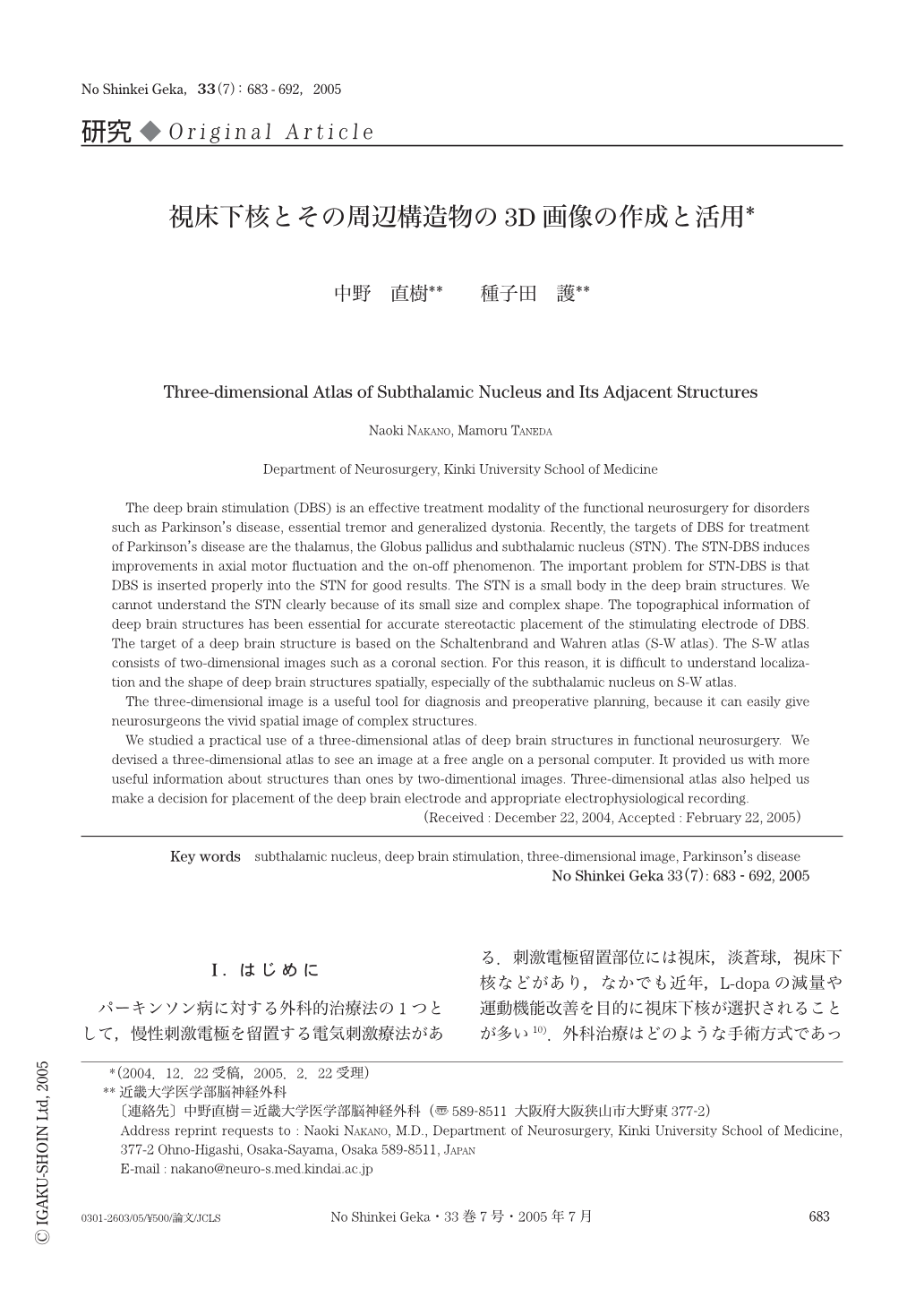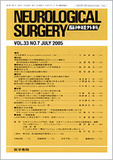Japanese
English
- 有料閲覧
- Abstract 文献概要
- 1ページ目 Look Inside
- 参考文献 Reference
Ⅰ.はじめに
パーキンソン病に対する外科的治療法の1つとして,慢性刺激電極を留置する電気刺激療法がある.刺激電極留置部位には視床,淡蒼球,視床下核などがあり,なかでも近年,L-dopaの減量や運動機能改善を目的に視床下核が選択されることが多い10).外科治療はどのような手術方式であっても,目標点の構造物を把握する必要がある.しかし,視床下核は体積144mm3の非常に小さな核で,その形は頭部MRIやSchaltenbrand and Wahren解剖図譜によれば,後外側下方から正中前方上方に長軸方向のあるフットボールや卵型であることがわかっている6,9,12).したがって,われわれがこのような視床下核の3次元構造を理解することは容易ではない.
元来,脳深部電気刺激術のような定位脳手術は目標点を座標で決定するため,構造物の立体把握は必ずしも必要ない.しかしながら,手術シミュレーションや適切な電極留置計画のためには,その3次空間的理解は有用であると考えられる.神経解剖学書によれば,3次元構造の理解のためにはしばしば複数の画像図を用いて説明されている.ただし,紙上であるため複数の構造図から現実の構造をイメージすることは容易でない9).
近年,脳動脈瘤の3次元構造を表現するthree-dimensional computed tomography angiography(3D-CTA)が診断や治療計画に有用なように,3次元(3D)画像は立体構造の把握に非常に役立つ画像である4).3D画像はコンピューターソフトの発達により,パーソナルコンピューターでも容易に使用でき,作成も簡単になった.古くから定位脳手術の目標点である視床でも3次元画像化が試みられ,その内部の核の区分が明確となり,解剖学的な位置関係の把握での有効性が報告されている5,14,18).
本研究では,パーキンソン病に対する外科治療の脳深部刺激術における目標点である視床下核とその周辺部位の構造物の3D画像の作成とその活用について記述する.
The deep brain stimulation (DBS) is an effective treatment modality of the functional neurosurgery for disorders such as Parkinson's disease,essential tremor and generalized dystonia. Recently,the targets of DBS for treatment of Parkinson's disease are the thalamus,the Globus pallidus and subthalamic nucleus (STN). The STN-DBS induces improvements in axial motor fluctuation and the on-off phenomenon. The important problem for STN-DBS is that DBS is inserted properly into the STN for good results. The STN is a small body in the deep brain structures. We cannot understand the STN clearly because of its small size and complex shape. The topographical information of deep brain structures has been essential for accurate stereotactic placement of the stimulating electrode of DBS. The target of a deep brain structure is based on the Schaltenbrand and Wahren atlas (S-W atlas). The S-W atlas consists of two-dimensional images such as a coronal section. For this reason,it is difficult to understand localization and the shape of deep brain structures spatially,especially of the subthalamic nucleus on S-W atlas.
The three-dimensional image is a useful tool for diagnosis and preoperative planning,because it can easily give neurosurgeons the vivid spatial image of complex structures.
We studied a practical use of a three-dimensional atlas of deep brain structures in functional neurosurgery. We devised a three-dimensional atlas to see an image at a free angle on a personal computer. It provided us with more useful information about structures than ones by two-dimentional images. Three-dimensional atlas also helped us make a decision for placement of the deep brain electrode and appropriate electrophysiological recording.

Copyright © 2005, Igaku-Shoin Ltd. All rights reserved.


